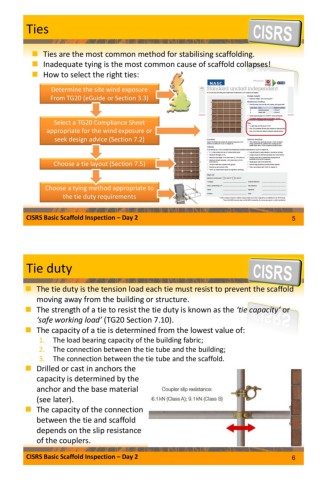
#BS 5973 SCAFFOLDING PDF PROFESSIONAL#
This paper presents a case study involving the investigation of a bridge scaffolding collapse where interdisciplinary expertise of professional divers, underwater investigators, and structural engineers was employed. Recent incidents of scaffolding collapses in the construction industry prompt the need for forensic investigations to help engineers have a better understanding of failures, their causes, and mitigation procedures. This curve is used to enable the factors of safety against collapse of the structure to be calculated.
#BS 5973 SCAFFOLDING PDF SERIES#
A regression curve is fitted to a series of buckling load factors for different imposed loads. For the purposes of this research, however, it is necessary to determine buckling load factors for imposed load only, dead and wind loads being kept constant. In a standard finite element program, elastic buckling load factors are normally calculated by increasing all the applied loads simultaneously. This alternative analysis is used to generate tables of factors of safety. The solution obtained from the elasto-plastic analysis is compared with an alternative approach, which combined a linear elastic analysis and eigenvalue buckling with the use of member buckling interaction formulae given in the European Standard ENV. The influence of different types of fault in the structure on factors of safety is determined. All connections between standards and ledgers, and between standards and transoms, are considered to be semi-rigid. This may be facilitated by systems thinking – a way of looking for commonalities, dealing with dimensionality, multiple perspectives and looking for alignment between fragmented professional and social silos.Ī three-dimensional, nonlinear, elasto-plastic, finite element model of a scaffold structure typical of small domestic construction is developed in the chapter with the objective of determining the factors of safety against collapse.

Models of how ‘latent’ hazards, technical and social, are given, but all require engineers to think in an integrated way – to cross disciplinary boundaries between ‘hard’ physical technical systems and ‘soft’ managerial ones. Technical reports are embedded in human and social systems and so forensic engineers must be sensitive to semantic subtleties regarding error, mistakes, accidents and disasters. As failure is exactly what engineers do not want it is all the more essential that we learn lessons when it does happen.


Failure is essential to the growth of knowledge. How is engineering safety best served by forensic science and engineering that pertains to legal processes? A critical question for a lawyer is ‘who is trying to do what to whom?’ The primary concern of the court is not an abstract inquiry into the causes of an incident but to establish who is to blame.


 0 kommentar(er)
0 kommentar(er)
